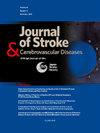急性卒中后常规计算机断层扫描(CT)上的神经成像生物标志物及其与卒中后谵妄的关系:一项队列研究
IF 2
4区 医学
Q3 NEUROSCIENCES
Journal of Stroke & Cerebrovascular Diseases
Pub Date : 2025-03-30
DOI:10.1016/j.jstrokecerebrovasdis.2025.108302
引用次数: 0
摘要
背景:急性脑卒中后四分之一的患者会出现谵妄,且预示着较差的预后。这项实用性研究的目的是确定通过常规进行的计算机断层扫描(CT)脑成像获得的区域萎缩定性评估或定量评估是否能识别出最有可能发生谵妄的患者:我们招募了 95 名急性中风(年龄≥60 岁)(缺血性或脑出血)患者,为期一年。在 1、3、5、7、14、21、28 天、4 个月和 12 个月时对谵妄和认知能力进行随访。所有参与者都接受了常规脑部 CT 扫描(东芝 64 层或 128 层扫描仪)(中风发生后 24 小时内)。对白质病变和萎缩进行定性评分(轻度、中度、重度)。对多个特定区域的萎缩进行定量测量:在 12 个月的随访期间,有 26 人(27%)出现了谵妄。经单变量分析,谵妄与年龄增加、女性、中风前日常生活活动独立性较差、中风前已有认知障碍、中风严重程度增加、全前循环中风和脑 CT 显示全脑萎缩有关。多变量分析表明,只有全脑萎缩、女性和更严重的中风才能预测谵妄。该模型占谵妄变异的 38% 至 55%。对于定量 CT 分析,单变量分析显示,谵妄与几个特定脑区的萎缩有关。在多变量分析中,只有 NIHSS(每增加一个点 OR 1.23,95% CI 1.06-1.43;p=0.006)和贮水池埋藏率(OR 1.41,95% CI 1.48-4.96;p=0.028)显著相关。该模型可解释 35.1% 至 51.2% 的谵妄变异:临床变量与常规脑CT定性萎缩评估或贮水池ambiens比值相结合,可识别出谵妄风险最高的脑卒中患者,并在谵妄预防和治疗的临床试验中对患者进行分层。本文章由计算机程序翻译,如有差异,请以英文原文为准。
Neuroimaging biomarkers on routine Computed Tomography (CT) after acute stroke and their association with post-stroke delirium: A cohort study
Background
Delirium affects a quarter of patients after acute stroke and predicts poorer outcomes. The aim of this pragmatic study was to determine whether either qualitative assessment or quantitative assessments of the regional atrophy obtained from routinely performed computed tomography (CT) brain imaging could identify patients most at risk of developing delirium.
Methods
We recruited 95 patients with acute stroke (age ≥60) (ischaemic or intracerebral haemorrhage) over one year. Follow-up for delirium and cognition was performed at 1, 3, 5, 7, 14, 21, 28 days, 4 months and 12 months. All participants underwent routine CT brain (Toshiba 64-slice or 128-slice scanner) (within 24 h of stroke onset). White matter lesions and atrophy were rated qualitatively (mild, moderate, severe). Atrophy in multiple specific areas was measured quantitatively.
Results
Twenty-six (27 %) developed delirium during the 12 months of follow-up. On univariable analysis, delirium was associated with increasing age, being female, less independent in pre-stroke activities of daily living, pre-existing cognitive impairment, increasing stroke severity, having had a total anterior circulation stroke and global cerebral atrophy on brain CT. Multivariable analysis demonstrated that only global cerebral atrophy, being female and having a more severe stroke predicted delirium. This model accounted for between 38 % and 55 % of the variance in delirium.
For quantitative CT analysis, on univariable analysis, delirium was associated with atrophy in several specific brain areas. On multivariable analysis, only NIHSS (for every one point increase OR 1.23, 95 % CI 1.06–1.43; p = 0.006)) and cistern ambiens ratio (OR 1.41, 95 % CI 1.48–4.96; p = 0.028) were significantly associated. This model accounted for between 35.1 % and 51.2 % of delirium variance.
Conclusion
Clinical variables together with either qualitative atrophy assessment or cistern ambiens ratio on routine CT brain could identify stroke patients most at risk of delirium and to stratify patients in clinical trials of delirium prevention and treatment.
求助全文
通过发布文献求助,成功后即可免费获取论文全文。
去求助
来源期刊

Journal of Stroke & Cerebrovascular Diseases
Medicine-Surgery
CiteScore
5.00
自引率
4.00%
发文量
583
审稿时长
62 days
期刊介绍:
The Journal of Stroke & Cerebrovascular Diseases publishes original papers on basic and clinical science related to the fields of stroke and cerebrovascular diseases. The Journal also features review articles, controversies, methods and technical notes, selected case reports and other original articles of special nature. Its editorial mission is to focus on prevention and repair of cerebrovascular disease. Clinical papers emphasize medical and surgical aspects of stroke, clinical trials and design, epidemiology, stroke care delivery systems and outcomes, imaging sciences and rehabilitation of stroke. The Journal will be of special interest to specialists involved in caring for patients with cerebrovascular disease, including neurologists, neurosurgeons and cardiologists.
 求助内容:
求助内容: 应助结果提醒方式:
应助结果提醒方式:


